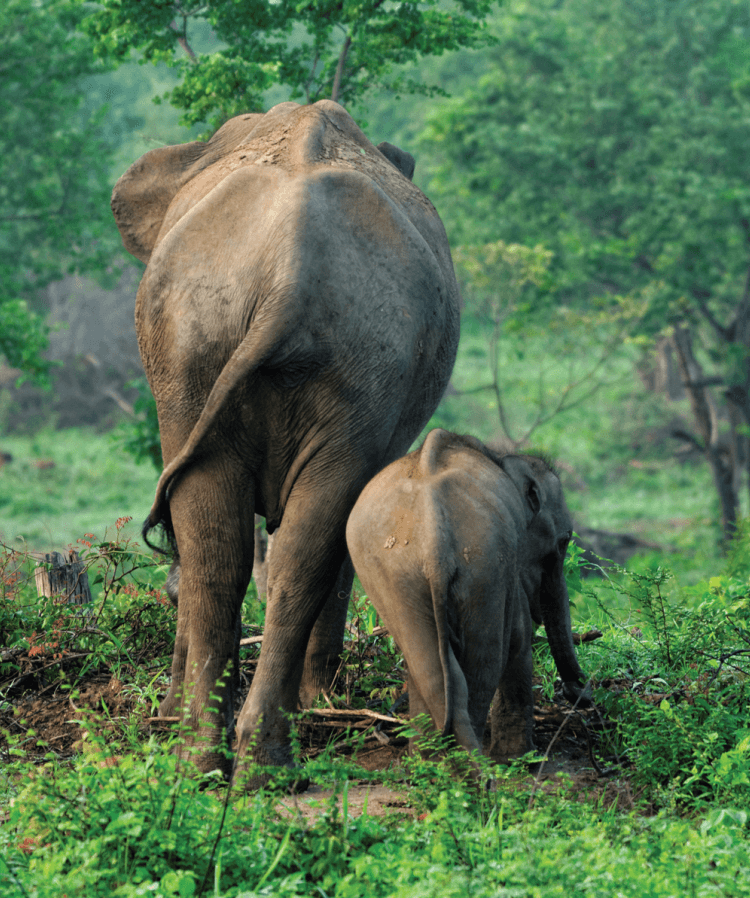
When done well, wildlife tourism can help protect wild animals and provide local communities with vital sources of income.
Being a mindful traveller means you can be a part of the solution instead of being part of the problem. Aim to find animal-loving ways to spend your tourist dollars.
Five of the best
1. Photograph wild animals in the wild
Observe and photograph wild animals in their natural environments where they exhibit naturally fascinating behaviours. For example, Sri Lanka has the highest density of wild Asian elephants in the world. See tigers in their natural habitat in Ranthambore National Park in India, part of a national conservation initiative. Take a safari through one of Africa’s national parks to see big cats and other animals interacting in family groups.
2. Visit animal sanctuaries for close-up experiences that benefit the animals too
There are numerous sanctuaries for animals who have been orphaned, affected by habitat loss, illegally traded, injured or rescued from abusers. In many cases these animals can not be released, but a sanctuary will always work towards rehabilitation and release if possible. Look for a sanctuary accredited by the Global Federation of Animal Sanctuaries, which has rigorous standards of sanctuary management and animal care.
3. Snorkel or dive in waters where sea life abounds
You can spot six of the world’s seven species of turtle on the Great Barrier Reef including green turtles and the increasingly rare loggerhead. Seek out one of about twenty locations worldwide where you can swim near while sharks.
4. Encounter dolphins and whales in the wild
You’ll find whale watching cruises the world over, and where there are whales there are usually dolphins. Seeing these magnificent creatures leaping out of the water as part of their natural behaviours beats seeing one bounce a ball on its nose in a pool any day.
5. Volunteer at a wildlife conservation or rescue organisation
Well-managed sanctuaries will limit contact with animals, and volunteers will work more on data collection, habitat enrichment and enclosure maintenance, all of which have a positive impact on the lives of the animals at the sanctuary. Be wary of money-making enterprises that have nothing to do with conservation.
Seeing wild animals when you travel can be a memorable part of your travel experience. However, you may not be aware captive animals often suffer unseen cruelty and abuse. Many wild animals are taken from their natural environments to be exploited for entertainment and profit. When you see a captive wild animal on your holiday, often you can’t see the cruelty. It’s hidden from view. A good ground rile is if you can ride or touch it, take a photo with it, or see it perform tricks, you can be sure it’s cruel.
Ten of the worst
1. Riding elephants
To make elephants submit to giving rides, they are taken from their mothers when babies and ‘broken’ with bull hooks and batons to establish the dominance of the keeper. Elephants are a dangerous animal to handle, so they are often controlled with these methods throughout their lives, while being prevented from forming family and social relationships.
2. Taking tiger selfies
Tiger cubs are separated from their mothers when just a few weeks old so they can be hugged and handled by hundreds of tourists a day. They are often punished using pain and fear to prevent aggressive behaviours and it’s not unusual for them to be drugged or tied down for the petting pleasure of tourists.
3. Walking with lions
Similar to tiger cubs, lion cubs are taken from their mothers within a month of birth so tourists can handle them and pose for photos. When the cubs are too big to pick up but still young enough to control, they are used for a walking with lions experience and then face a lifetime of captivity.
4. Visiting bear parks
Bears are kept in barren, overcrowded ‘pits’ with little or no behavioural enrichment. They are solitary creatures in the wild so are prone to infighting when in captivity. And there is nothing more unnatural than dressed up or performing bears.
5. Holding sea turtles
Holding a sea turtle causes it to suffer a great deal of stress which can weaken its immune system and increase its susceptibility to disease. When handled by tourists, they often panic and intensely flap their flippers, which can cause fractures and detached claws.
6. Performing dolphins
Dolphins are often captured from the wild with nets or chased down by high-speed boats before being hauled on board. They then spend their entire lives in a space not much bigger than a swimming pool – completely unnatural compared to their natural open sea environment.
7. Dancing monkeys
Many species of primates are used for street entertainment. For example, macaques are trained aggressively and painfully, to make them walk, behave and appear more human. When they’re not performing, the macaques are often kept chained in small, barren cages.
8. Touring civet coffee plantations
When pellets are collected from civets in the wild, no cruelty is involved. But in an attempt to produce more civet coffee, farmers have started catching the civets and keeping them in small, crowded cages where they are encouraged to gorge on an unbalanced diet of coffee cherries.
9. Charming snakes or kissing cobras
The cobras used for street entertainment are usually captured from the wild, then defanged with metal pliers and their venom ducts are either blocked or removed – often with unsanitised equipment. This can result in painful infections and can kill them.
10. Farming crocodiles
Large numbers of crocodiles are being kept on farms and intensively bred – mainly to supply the fashion industry with their skins, but also for their meat. These farms are a common wildlife tourism experience. The animals are usually housed in concrete pits and conditions are often severely overcrowded and unhygenic.
The more we can be aware of the way animals are being treated, the more we’ll be able to protect them from cruelty and suffering. Being animal friendly when you travel means you always show respect – for the people, the culture, the environment and the animals, in every country you visit. Many of us have taken part in activities we didn’t realise were harmful at the time. So, let’s focus on learning the issues and making better choices going forward.
Will you take the pledge to be an animal friendly traveller? Sign up at worldanimalprotection.org.au/be-animal-friendly-traveller





















